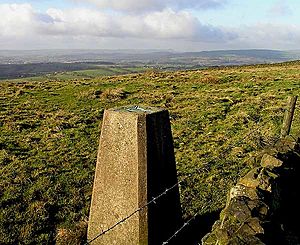Morridge facts for kids
Morridge is a special area of land in Staffordshire, England. It is located a few miles east of the town of Leek. This area is part of the Staffordshire Moorlands, which is a local government district.
Contents
What is Morridge?
Morridge is a long, high area of land known as a ridge. It is covered in moorland, which means it's often open land with low-growing plants like heather.
Where is Morridge Located?
The northern part of Morridge is called Morridge Top. It is about one mile south of a village named Flash. Further south, near a place called Upper Hulme, you can find a trig point at Merryton Low. A trig point is a special marker used by mapmakers to measure heights. This one is about 489 meters (1,604 feet) high. The southern end of Morridge reaches towards the villages of Onecote and Bradnop.
What Does Morridge Look Like?
Morridge is mostly open countryside. It has wide views and is a great place for outdoor activities. The land rises and falls, creating a unique landscape that is important for both nature and farming.
History of Morridge Land
For a very long time, Morridge has been used for farming. In the Middle Ages, it was used as pasture land, where animals could graze. Even today, dairy farming (for milk) and sheep farming are very common there.
Who Owned the Land?
In the 1500s and 1600s, some powerful families tried to change how the land was used. Sir Edward Aston, along with his son Walter, 1st Lord Aston, and his grandson Walter, 2nd Lord Aston, wanted to enclose large parts of Morridge.
What Was Enclosure?
Enclosure meant fencing off open land that was once shared by many people. This would turn it into private farms. However, many local people, called freeholders, had rights to use this land. They fought against these enclosure plans, and because of their resistance, much of Morridge stayed open for a long time.
When Did Full Enclosure Happen?
It wasn't until 1769 that a full-scale enclosure of Morridge finally took place. This changed the landscape and how the land was used, making it more like the private farms we see today.


